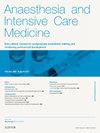Pre-optimization of the anaemic patient
IF 0.2
Q4 ANESTHESIOLOGY
引用次数: 0
Abstract
Anaemia affects a significant number of preoperative patients and has independently been associated with increased morbidity and mortality. Identification, assessment, and treatment of preoperative anaemia is now widely accepted as a new standard of care for patients. There remains a lack of conclusive evidence that optimizing the haemoglobin (Hb) preoperatively impacts on the increased risks, but there is increasing evidence normalizing iron stores has a positive impact.
The commonest cause of anaemia in this setting is iron deficiency. It is important to consider and exclude other causes, there are established recommendations for screening investigations. Early identification allows time for Hb optimization. Oral iron replacement is advised first line, however there are often time constraints and tolerability concerns. In some circumstances surgical delay is appropriate. It is important patients understand the rationale behind management and are involved in the decision-making process. Where possible, red cell transfusions are avoided preoperatively given associations with worse surgical outcomes, there may be circumstances however where both transfusions and erythropoiesis stimulating agents are considered.
As evidence and research in this field grows hospitals should develop preoperative anaemia care pathways to ensure appropriate screening investigations are performed and management delivered.
求助全文
约1分钟内获得全文
求助全文
来源期刊

Anaesthesia and Intensive Care Medicine
ANESTHESIOLOGY-
CiteScore
0.50
自引率
0.00%
发文量
152
期刊介绍:
Anaesthesia and Intensive Care Medicine, an invaluable source of up-to-date information, with the curriculum of both the Primary and Final FRCA examinations covered over a three-year cycle. Published monthly this ever-updating text book will be an invaluable source for both trainee and experienced anaesthetists. The enthusiastic editorial board, under the guidance of two eminent and experienced series editors, ensures Anaesthesia and Intensive Care Medicine covers all the key topics in a comprehensive and authoritative manner. Articles now include learning objectives and eash issue features MCQs, facilitating self-directed learning and enabling readers at all levels to test their knowledge. Each issue is divided between basic scientific and clinical sections. The basic science articles include anatomy, physiology, pharmacology, physics and clinical measurement, while the clinical sections cover anaesthetic agents and techniques, assessment and perioperative management. Further sections cover audit, trials, statistics, ethical and legal medicine, and the management of acute and chronic pain.
 求助内容:
求助内容: 应助结果提醒方式:
应助结果提醒方式:


